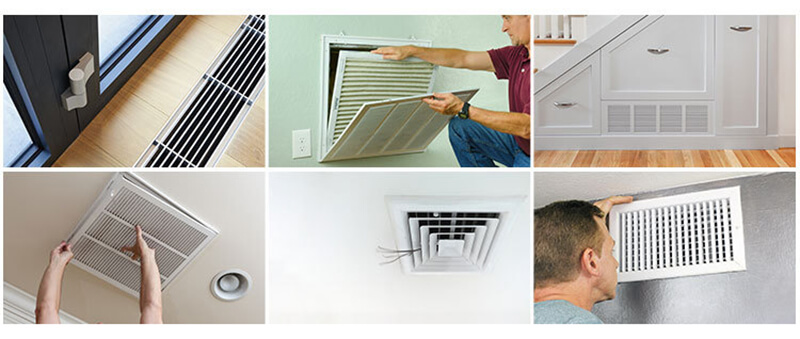HVAC vent covers are crucial components of your home’s heating, ventilation, and air conditioning system. They serve not only functional purposes—such as directing airflow and filtering out debris—but also aesthetic ones, blending seamlessly into your home’s interior design. Understanding when and why to replace these covers can enhance your system’s efficiency, improve air quality, and revitalize the look of your living space. Whether due to wear and tear or a desire for a fresh update, replacing HVAC vent covers is a practical improvement that homeowners can undertake with confidence.
Understanding HVAC Vent Covers
What Are HVAC Vent Covers?
HVAC vent covers, also known as registers or grilles, are the visible and accessible parts of your HVAC system that cover the air duct openings in your home. Their primary function is to control the airflow, filter out particulates, and protect the ductwork from intrusion.
Types of Vent Covers
Vent covers come in various types, each suited to specific locations and functions within your home:
- Floor Vents: Positioned on the floor, these are typically made to withstand foot traffic and are often found in high-use areas like living rooms and hallways.
- Ceiling Vents: These vents are mounted on the ceiling and are used to distribute air evenly throughout a room.
- Wall Vents: Installed on walls, they are used primarily for intake purposes or in rooms where floor and ceiling placement isn’t feasible.
Materials and Styles
The choice of material for vent covers can affect both their durability and aesthetic appeal:
- Metal: Durable and traditional, metal vent covers often feature designs that can range from minimalist to intricate.
- Plastic: Lighter and less expensive, plastic covers come in various colors and are rust-resistant, making them suitable for humid environments.
- Wood: Offering a classic look that can be stained or painted, wood vent covers blend well with floors and can be crafted to match interior trim or furniture.
Size and Fit
Selecting the right size vent cover is crucial for maintaining optimal airflow and system efficiency. Measure the opening of your duct carefully, noting the length and width, and ensure that the cover’s dimensions correspond exactly to prevent gaps or airflow restrictions. Proper fit not only ensures efficient operation but also prevents vibrational noise and energy losses.
When to Replace HVAC Vent Covers
Recognizing the Signs of Wear
HVAC vent covers can last many years, but several signs indicate when they need replacement:
- Physical Damage: Dents, cracks, or broken parts can impair vent functionality and aesthetics.
- Corrosion and Rust: Metal vent covers may rust over time, especially in high-humidity areas, affecting air quality and vent durability.
- Inefficient Airflow: If rooms are not receiving adequate air circulation or if there are noticeable drafts, the vent covers might be misaligned or damaged.
The Benefits of Replacing Old Vent Covers
Replacing your HVAC vent covers offers several advantages:
- Enhanced Air Quality: New vent covers can better control dust and other airborne particles, contributing to cleaner indoor air.
- Improved System Efficiency: Properly fitting and undamaged vent covers ensure optimal airflow, enhancing the overall efficiency of your HVAC system.
- Updated Home Aesthetics: New vent covers can significantly refresh the look of a space, aligning with modern interior design trends or personal style preferences.
Choosing the Right Vent Covers
Material Considerations
When selecting vent covers, the material choice is crucial for both function and style:
- Durability: Metal covers are robust and offer longevity, whereas plastic covers might need more frequent replacement but resist corrosion better.
- Appearance: Consider how the vent covers will complement your home’s interior. Wood can offer a warm, traditional feel, while metal can be either modern or classic, depending on the design.
- Cost: Budget considerations will also play a role; metal and wood are generally more expensive than plastic.
Design and Aesthetics
Choosing a vent cover is also an opportunity to enhance your home’s design:
- Style Match: Ensure the vent cover style matches the room’s overall theme—whether contemporary, traditional, or rustic.
- Custom Options: Some suppliers offer custom designs that can perfectly match your existing decor or desired aesthetic.
Choosing the Right Vendor
Selecting the right vendor is key to finding quality vent covers:
- Reputation: Look for vendors with positive reviews and a strong reputation for quality.
- Selection: Choose vendors that offer a wide range of styles and materials.
- Customer Service: Good customer service can make the process of replacing your vent covers much smoother, especially if you need guidance on sizing or installation.
Step-by-Step Replacement Guide
Preparation: Tools and Materials Needed
Before beginning the replacement process, ensure you have all the necessary tools and materials to make the job smooth and efficient:
- Measuring Tape: To confirm the size of your current vents and the new covers.
- Screwdriver: Depending on the type of vent cover, you might need a flathead or Phillips screwdriver.
- New Vent Covers: Purchased according to the size and type determined in previous steps.
- Cleaning Supplies: Cloth and cleaning solution to clean the duct opening before installation.
Step 1: Removing the Old Vent Covers
Carefully removing the old vent covers is crucial to avoid damaging the surrounding areas:
- Turn Off the HVAC System: Ensure your system is off to prevent dust and debris from circulating.
- Unscrew the Existing Cover: Use the appropriate screwdriver to remove screws, if any. Some vent covers might simply snap off without screws.
- Clean the Area: Once removed, clean the vent opening with your cloth and cleaning solution to prepare for the new cover.
Step 2: Installing the New Vent Covers
Installing new vent covers is straightforward but requires attention to detail to ensure they fit securely:
- Align the New Cover: Place the new vent cover over the duct opening, making sure it aligns perfectly with the opening and any screw holes.
- Secure in Place: Screw in or snap the cover into place, depending on the design. Do not overtighten screws, as this could damage the cover or the ductwork.
- Check for Air Leaks: After installation, briefly turn the HVAC system on to check for any air leaks around the edges of the vent cover. Adjust as necessary to ensure a tight fit.
Final Inspection and Testing
Once the new vent covers are installed, perform a final inspection to ensure everything is in order:
- Visual Inspection: Ensure the covers are flush with the surface and that there are no gaps.
- Operational Test: Turn on the system and observe if the airflow is consistent and if there are no unusual noises, which might indicate a loose cover.
Maintenance Tips
Regular Cleaning
Maintaining your HVAC vent covers involves routine cleaning to ensure they function effectively and maintain their appearance:
- Frequency: Clean your vent covers at least every three to six months, or more often in high-dust areas.
- Method: Use a vacuum with a soft brush attachment to remove dust and debris. For deeper cleaning, remove the cover and wash with warm soapy water, especially for plastic or metal covers.
Inspection Routine
Regular inspections can prevent small issues from becoming major problems:
- Visual Checks: Look for signs of damage, rust, or dust build-up that can impede airflow.
- Operational Checks: Listen for any unusual noises that indicate loose covers or obstructions in the vents.
Professional Checks
Consider having a professional HVAC technician inspect your entire system annually. This can include checking vent covers as part of a broader system health check.
Conclusion
HVAC vent covers play a pivotal role in the overall functionality and efficiency of your home’s heating and cooling systems. Replacing old or damaged vent covers not only enhances air quality and system performance but also uplifts your home’s interior aesthetics.
If you want to know more, please click below:
- Grilles, Registers & Diffusers – The Ultimate Guide
- HVAC Linear Slot Diffusers – The Ultimate Guide
- HVAC Egg Crate Diffuser – The Ultimate Guide
- HVAC Jet Nozzle Diffuser – The Ultimate Guide
- HVAC Linear Bar Grilles – The Ultimate Guide
- HVAC Air Swirl Diffusers – The Ultimate Guide
- HVAC Round Ceiling Diffusers – The Ultimate Guide
- Round Ceiling Diffusers – The Ultimate Guide
- Exhaust Air Louver – The Ultimate Guide
- HVAC Registers – The Ultimate Guide


